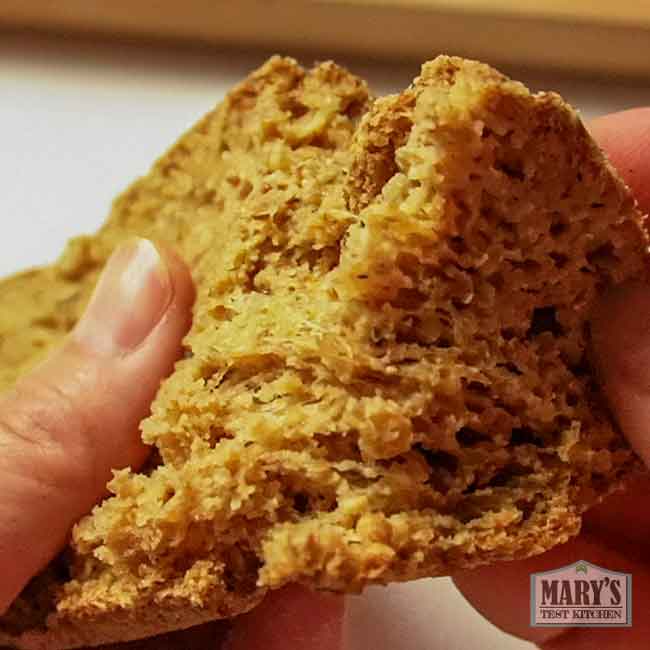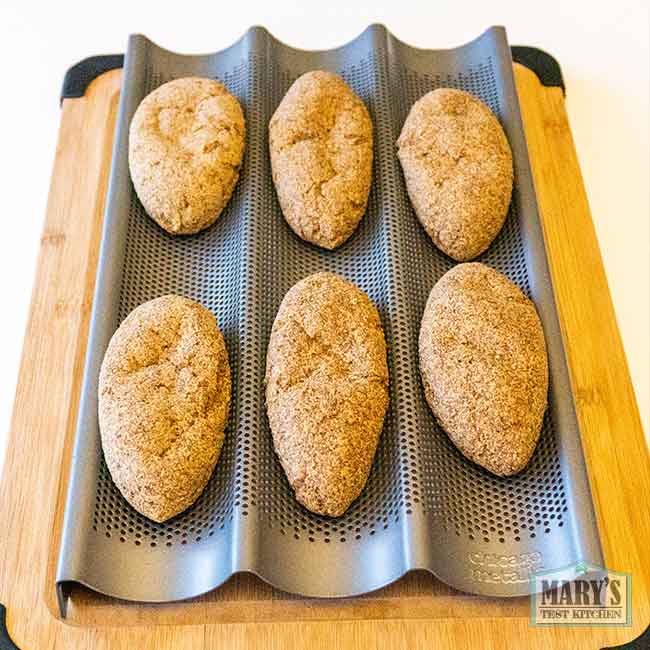Vegan keto bread that’s also gluten-free? Oh yes, my friends. After all your requests for a wheat-free version of my vegan keto sandwich buns, weeks of testing, fails and more than one emotional breakdown, I give you this fantastic-tasting recipe for Vegan Keto Gluten-Free Sandwich Rolls!
Video Tutorial for Vegan Keto Gluten-Free Sandwich Rolls
Why make Vegan Keto Gluten-Free Sandwich Rolls?
You might prefer the exceptional toasty flavour of these gluten-free rolls whether you need to be low-carb or not, gluten-free or not! They are THAT delicious. But I originally started making vegan bread for selfish reasons: to stay in ketosis in order to keep my chronic tendonitis symptoms away, while still being able to have sandwiches now and again.
Then, I wanted to make THIS particular recipe because I came across an unbelievably delicious gluten-free keto bread at the grocery store but it was so expensive. It was Unbun’s plant-based keto gluten-free buns. At $10.99 CAD for four buns, they were much too pricey for me to buy on any kind of regular basis. So I had to reverse engineer it.

Ingredients for Vegan Keto Gluten-Free Sandwich Rolls
This low carb bread bakes up quite differently compared to traditional bread recipes but the result is still phenomenal. Especially in taste due the to fragrant aromas from baking almond and coconut flours, plus psyllium seed husk. Plus, this vegan keto gluten-free dough is leavened without yeast so you don’t have to wait for anything to rise; just mix, shape and bake!
Almond Flour
The first dry ingredient is almond flour; a keto baking staple ingredient. Almond flour is made from finely grinding whole almonds that have had the papery brown skin removed. You might also find it sold as super fine almond meal. Just look for the one that’s purely a creamy white, rather than the one with brown speckles in it.
Protein Powder
My inspiration for these buns, Unbun Plant-Based Buns, uses pumpkin seed protein powder. However, at the time of development, I couldn’t find any to purchase so I used soy protein isolate instead and it worked beautifully. Subsequently, I did end up finding pumpkin seed protein powder on Amazon and it works too so you can use either one. However, pumpkin seed protein is much more expensive than soy protein isolate.
Coconut Flour
Coconut flour is nearly pure coconut meat fiber after the fat has been extracted, making this another staple keto baking ingredient. It has a natural sweetness to the flavour and wonderful aroma, especially after baking. It absorbs more water than one might expect and when eating breads made with it, I always suggest drinking plenty of water too.

Psyllium Seed Husk Powder
You might know psyllium seed husk by a more famous brand name: Metamucil. But don’t head to the pharmacy section to purchase it. Psyllium seed husk is much more affordable from the bulk food section of your grocery store.
This ingredient is pure fiber which is not digestible which helps to give this bread bulk without adding protein or carbs. It also absorbs water and adds lightness to the recipe. And like coconut flour, it adds a nice toasty aroma to the bread when its baked.
Ground Golden Flax Seed
Flax seed is famous for being a plant-based egg alternative in baking and for containing ALA, the plant-based source of Omega-3’s. I find golden flax seed a lot nicer to look at compared with regular brown flax so I prefer it for baking. When ground and mixed with water, flax seeds take on water and form a sticky gel. This give this keto gluten-free bread dough more cohesion so you can shape the buns without them crumbling away.
Leavening Agents
To help this bread’s texture become fluffy on the inside, three ingredients act together: baking soda, cream of tartar, and apple cider vinegar. Instead of trying to use yeast (which would have a hard time as there are barely any carbs for them to munch on), these three leavening agents reliably give lift to the bread. It’s the same kind of combination that is used for muffins and other similar quick breads.
Salt
Don’t forget the salt in this recipe; it brings out the flavour!
Olive oil
Olive oil helps to tenderize the bread and adds it’s own delicious flavour. Don’t skip it.
Water
The water content in this recipe is quite important. I have tested using a little less water and a little more and each time the texture was negatively affected. When I used less water, the bread became more more dense; similar to cornbread. When I used less water, the rolls collapsed too much during baking.
Cost of Making Vegan Keto Gluten-Free Sandwich Rolls
When I added up the cost of all the ingredients for this recipe, I was pleasantly surprised! Each roll worked out to cost $1.28 (Canadian) from a batch of 6 buns. The cost for the entire recipe was $7.68. This is quite the savings compared to buying the original Unbun Plant-Based Buns which were $10.99 for 4 smaller buns.

However, if the ingredients are not part of your regular pantry items, buying all the products at once could be cost prohibitive. Plus, the chart above does not include the cost of running your oven or your own valuable time. You’ll have to decide whether it’s worth it for yourself.

For me, of course, I find it well worth the cost and time. At the same time, I view all keto breads as a treat food. While these ingredients are quite recognizable, I would not regard this recipe to be whole food based or minimally processed. So therefore, they’re not a part of my everyday diet. And because of all the isolated fibers, it’s important to drink plenty of water when having these as part of your meals.
Nutrition Information
These Vegan Keto Gluten-Free Sandwich Rolls contain 3.9 grams of net carbs, 10.8 grams of protein, and 21.6 grams of fat; all from plant-based ingredients.

Printable Recipe for Vegan Keto Gluten-Free Sandwich Rolls
Vegan Keto Gluten-Free Sandwich Rolls

Vegan Keto Gluten-Free Buns with fluffy interior and toasty exterior that taste absolutely delicious! Not weird or gummy. For best results, measure by weight.
Ingredients
dry ingredients
- 6 tbsp almond meal (42g)
- 6 tbsp soy protein (36g)
- 6 tbsp coconut flour (54g)
- 12 tbsp psyllium husk powder (48g)
- 6 tbsp ground golden flax (42g)
- 1 1/2 tsp baking soda
- 3/4 tsp cream of tartar
- 3/4 tsp salt
wet ingredients
- 1 3/4 cup + 2 tbsp water (450ml)
- 6 tbsp olive oil (90ml)
- 1 1/2 tsp apple cider vinegar (7.5ml)
Instructions
- Preheat oven to 400°F
- In a large mixing bowl, combine all dry ingredients. Mix very well. Separately, combine wet ingredients. Pour wet ingredients into dry and stir with a spatula. At first, the texture may seem too wet; just wait, it will become thick and fluffy.
- Divide the mixture into 6. Using a small mixing bowl and a spatula, shape one portion into a roll shape. If you find the roll crumbling or falling apart, make sure to use a patting motion rather than a rolling motion. You may use your hands moistened with water or oil to help.
- Place shaped roll on an oiled or parchment lined baguette pan. Repeat with the remaining 5 portions.
- Bake at 400°F on the middle rack for 15 minutes. Then turn the heat down to 350°F and continue baking for 40 minutes.
Notes
To make this recipe soy-free, you can substitute the soy protein isolate with unflavoured pumpkin seed protein powder.



Thank you for this recipe! I am not vegan nor gluten free but I’ve been in search of a low carb bread that isn’t dense and doesn’t go flat and this, this miracle, is it❤️. I contemplated making your recipe for the same type bun with yeast, gluten, oat fiber etc. but I was pushed for time and honestly just wanted to try this simple looking recipe and I’m so very glad I did. I didn’t have the soy protein powder but I had whey protein powder so that’s what I used. I held my breath the whole time they were in the oven because I’ve had so many failures trying to make low carb bread, buns etc. These are spot on and I couldn’t be happier! Would love to know if a loaf could be made with this.. I’m thinking yes but not sure what the baking time would be. Again, thank you so much!!
I wanted to love it, but I couldn’t stomach it. The flax is just way too obvious and the chew just isn’t good in my opinion. It’s like what we try to avoid with flax meal in baked goods. Almost like a rubbery but slimy feel? I mean I think it came out correct, it was soft and the bread did look really good actually, but I ended up throwing these out. I’m a pretty good bread maker, so I sort of know how to handle bread dough. I was looking for something that had more protein perhaps a bit lower in carbs, but wo all the bs. This just wasn’t for me. Is there a texture difference between the golden flax vs the brown? I highly doubt that, but maybe someone knows something that I don’t? This would be a good idea, but is there anything other than flax meal that can be used? Another kind of seed? Maybe almond flour with a little bit of flax meal? Or what about chickpea flour? Sorry I really wanted this to work, I really did, but it didn’t work for me. Plus the flax taste was very much there, it actually made me a bit nauseas. Maybe the golden wouldn’t be as strong? Anyway I wasted a cup + of flax meal and other ingredients. But it was worth a try. If there is something I may have done wrong please enlighten me, but like I said, the potato shape rolls looked a lot like yours, only darker (since I used brown flax). Ahhh well! Best
Hi
Amazing bread! I love it and so easy to make.
The only thing I don’t get is why it smells like mushroom on the inside.. Do you have a guess?
The only thing I change was substituting backing soda and tartar with backing powder..
Sincerely
Jonas
Hi Jonas,
I’m glad the recipe worked for you for the most part. I don’t know why it would smell like mushrooms though.
Mary
Definitely planning to try this! Crazy question: Do you think it would work subbing in some of the spent almond pulp from making nut milk?
Yes I think so! Recently I did this with leftover chickpea milk pulp. For almond pulp, which is a bit different, I might only use it to sub the oat fiber portion of the recipe. Just a guess though 🙂